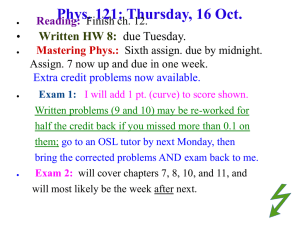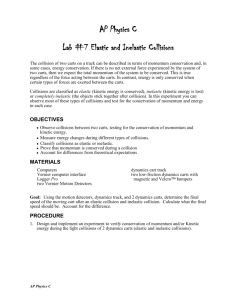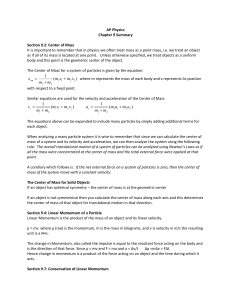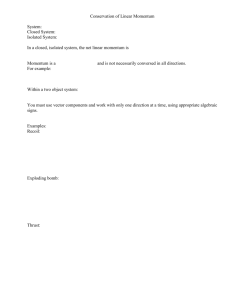Ch 9 - Momentum and Collisions (No 2D)
advertisement
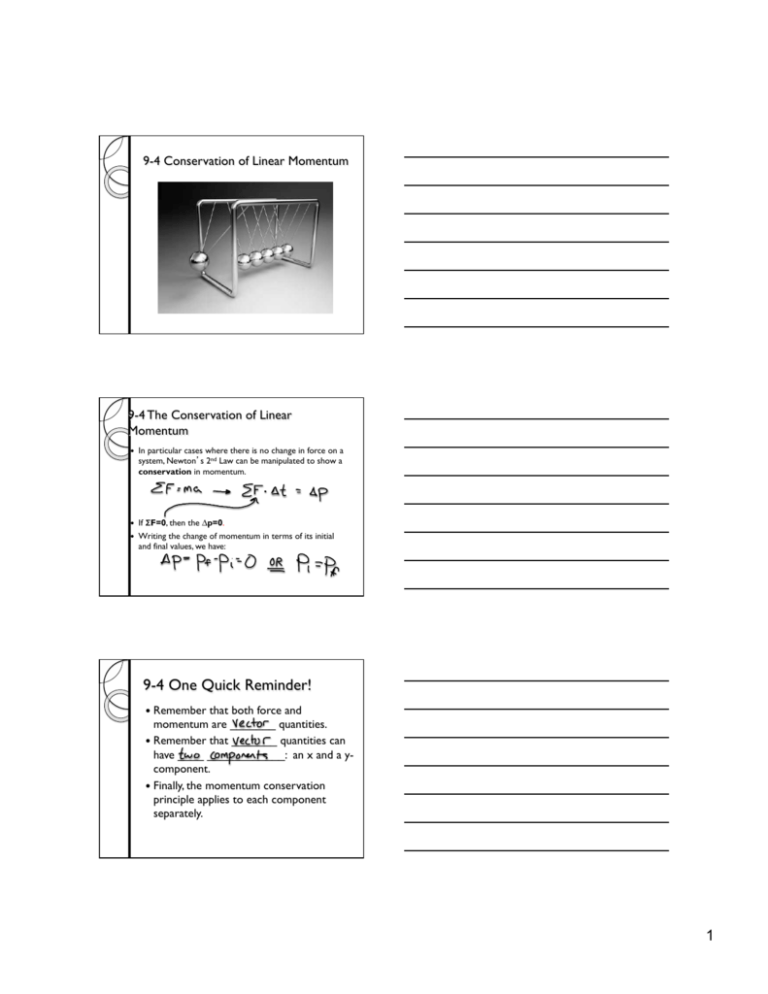
9-4 Conservation of Linear Momentum 9-4 The Conservation of Linear Momentum In particular cases where there is no change in force on a system, Newton’s 2nd Law can be manipulated to show a conservation in momentum. If ΣF=0, then the ∆p=0. Writing the change of momentum in terms of its initial and final values, we have: 9-4 One Quick Reminder! Remember that both force and momentum are _______ quantities. Remember that _______ quantities can have ____ ____________: an x and a ycomponent. Finally, the momentum conservation principle applies to each component separately. 1 Law of Conservation of Momentum Total momentum of a system remains the same when the net external force acting on the system is zero. General formula for two objects: m1v1i + m2v2i +… = m1v1f + m2v2f +… Collisions in more detail There are two main types of collisions ◦ ◦ Momentum is ___________ conserved in an ____________ collision, but mechanical energy is not always conserved If kinetic energy is lost in a collision, where does it go? Inelastic Collisions Total kinetic energy of the system is not conserved Loses KE, but not max ◦ In various forms: Deformation Sound Light Heat 2 9-5 Inelastic Collisions In any collision where the KE is not conserved, it is referred to as an inelastic collision. In an inelastic collision, the momentum of the system is conserved, but not its KE. Nearly all collisions in the world are a type of inelastic collision. 9-5 Inelastic Collisions In the case where the two objects “stick together” after the collision, it is said to be completely inelastic or perfectly inelastic. (Max KE lost) In the case where two objects “start together” and push away from one another, it is said to be a reverse inelastic collision or explosion. 9-5 Inelastic Collisions • The first bullet passes through the block and maintains much of its original momentum, but loses some KE • The second bullet, expands as it enters the block of wood, which prevents it from passing all the way through it. Most of the momentum transfers and a max KE is lost. • The third bullet bounces off the block transferring “all of its own momentum” and then borrowing some more from the block. This has the most momentum transferred to the block and loses no KE. 3 Conservation of Linear Momentum A honeybee with a mass of 0.150 g lands on one end of a 4.75 g popsicle stick. After sitting at rest for a moment, it runs toward the other end with a velocity vb relative to the still water. The stick moves in the opposite direction with a speed of 0.120 cm/s. What is the velocity of the bee? 9-6 Elastic Collisions In an elastic collision, momentum and KE are conserved. Most collisions are typically inelastic because with elastic collisions, KE is conserved, meaning no deformations, no sound, no heat. Elastic collision problem A 5.00-kg ball, moving to the right at a velocity of +2.00 m/s on a frictionless table, collides head-on with a stationary 7.50kg ball. Find the final velocities of the balls if the collision is elastic. 4 9-7 Center of Mass The center of mass of a system is the average position of all the mass in the system Mathematically, the position: mass-weighted average of xcm = This equation can be generalized to any number of particles and to two or more dimensions 9-7 Center of Mass To extend the definition further, think of a system in two dimensions instead of just one. In this case, the CM will have both an x and a ycomponent. 5 Calculating the Center of Mass The drawing shows a sulfur dioxide molecule. It consists of two oxygen atoms and a sulfur atom. A sulfur atom is twice as massive as an oxygen atom. Using this information and the data provided in the drawing, find the center of mass of the sulfur dioxide molecule. Calculating the Center of Mass XCM = (32)(0) + (16)(−.124) + (16)(.124) 0 = = 0 nm (32 +16 +16) 64 YCM = (32)(0) + (16)(.0715) + (16)(.0715) 2.288 = = 0.0358nm (32 +16 +16) 64 (0 nm, 0.358 nm) 6
